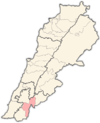|
Marjayoun
Marjayoun or Jdeidet Marjayoun (Arabic: مرجعيون: Lebanese pronunciation [ˈmaɾʒ.ʕajuːn]), also Marj 'Ayoun, Marjuyun or Marjeyoun (lit. "meadow of springs") which reflects the area's lush landscape and abundant water resources and Jdeideh / Jdeida / Jdeidet Marjeyoun, is a municipality, in the Marjeyoun District, Nabatieh Governorate in Southern Lebanon. HistoryCrusader periodOn June 10, 1179, during the Battle of Marj Ayyun, the Ayyubids defeated the Crusaders. The Crusader king narrowly escaped capture. [1] Ottoman periodIn 1596, 'Jadida' appears in the daftar of Ottoman nahiya (subdistrict) of Tibnin in the liwa' (district) of Safad, as a Muslim village of 28 households and 12 bachelors. The villagers paid a fixed tax-rate of 25% on agricultural products, such as wheat, barley, olive trees, vineyards, goats and beehives, in addition to "occasional revenues" and a press for olive oil or grape syrup; a total of 9,606 akçe.[2][3] In 1875 Victor Guérin visited Marjayoun (which he called Djedeideh), and found 2,000 inhabitants, mostly "Schismatic Greek" (i.e. Melkite Uniats), but also some Greek Orthodox and Muslims.[4] Saint Peter's Cathedral, built in 1892, was restored in 1968 after a fire.[5] 20th–21st centuriesDuring the Syria-Lebanon Campaign of World War II, British and Australian forces advancing from Palestine entered the town on 11 June 1941, but were forced to withdraw on 15 June following a Vichy French counterattack.[6] The Allies recaptured the town on 24 June in the Battle of Merdjayoun.[7] Marjayoun was the headquarters of the South Lebanon Army, the militia that controlled southern Lebanon during Israel's occupation of the region after the 1982 Lebanon War until its withdrawal from the region in 2000.[8] Following the pullout, many residents of Marjayoun fled to Israel, fearing accusations of collaboration.[9] On August 10, 2006, after the breakdown of ceasefire negotiations in the 2006 Lebanon War, Israeli forces took control of Marjayoun.[10] The next day, a convoy of 3,000 people fled from the town. The convoy was attacked by the Israeli Air Force (IAF) northeast of Hasbaya en route to Kefraya, in the south of the Bekaa valley. The bombing killed at least seven people, and is known as the Marjayoun convoy incident.[11] GeographyMarjayoun is 860 metres (2,822 ft) above sea level, standing on the west side of the Jordan Rift Valley just across from the ancient regional capital, Caesarea Philippi, which was located at the foot of Mount Hermon on the east side of the Rift Valley. Marjeyoun stands on a hill facing Mt Hermon to the east, the Crusader castle of Beaufort, set above the Litani River and overlooking Mount Amel (Jabal Amel), to the west, the Mount Lebanon range with the Rihan and Niha peaks to the north, with the fertile Marjeyoun plains extending southward into the Galilee plains and the Golan Heights. DemographicsIn 2014 Christians made up 74.36% and Muslims made up 25.36% of registered voters in Marjayoun. 39.05% of the voters were Greek Orthodox, 18.98% were Greek Catholics and 19.69% were Sunni Muslims.[12] Greek Orthodox (38.6%) Sunni Muslim (20.2%) Greek Catholic (18.7%) Maronite Catholic (10.4%) Shiite Muslim (6%) Other Christian Minorities (6.1%)
Religion in Marjayoun according to 2022 elections data The town of Marjayoun has a Christian majority population of about 5,000 people.[dubious – discuss] Greek Orthodox Christians compose the vast majority of the town's population, however, there are also Maronite and Greek Catholic Christians living in Marjayoun. Many Marjayouni Christian families trace their roots to the Hauran region, in present day Syria.[13] Outside the town, most villages in the surrounding valleys and mountains are predominantly Shia Muslim.[14] The Melkite Saint Peter's Cathedral was built in 1892 and restored in 1968 after a fire and in 2009.[15] Marjayoun is the seat of the Melkite (Greek Catholic) Archeparchy of Baniyas, which includes the southeastern part of Lebanon.[16] Parliamentary representationThe district of Marjayoun, which includes the town, is largely Shia Muslim. It holds three seats in the Lebanese government, two belonging to Shia Muslims and one belonging to Greek Orthodox Christians.[citation needed] HospitalMarjayoun is home to a regional government hospital founded in 1960,[17] and a Lebanese Red Cross First Aid Center.[18] This government hospital was closed due to Israeli attacks to Lebanon in October 2024 and killed and injured number of hospital staff.[19] Marjayoun AirfieldAn abandoned airfield is located 10 kilometres (6.2 mi) south of Metula. Ruins of buildings and outline of the runways and taxiway are all that remains. In a strategic triangle linking Lebanon with Israel and Syria are located the ruins of "Marjayoun Airport" or what is known as "Al-Marj Airport" or "English Airport". The green color of the Marjayoun Plain is only disturbed by forgotten walls from the days of World War II, their hard stones separating the fertile agricultural lands of the Marjayoun Plain. During the Second World War, the region of the Marjayoun Plain formed an arena of confrontation between the allies on one side and the German army on the other, so the allies had to fortify themselves, specifically in the Marjayoun Plain, which was a defensive area or a back line of confrontations if Egypt fell into the hands of the German army, or if the German Army managed to advance into Palestine, Lebanon and Syria.[20] Notable people
Climate
See also
References
Bibliography
External links
Photo galleries
Videos |
||||||||||||||||||||||||||||||||||||||||||||||||||||||||||||||||||||||||||||||||||||||||||||||||||||||||||||||||||||||||||||||||


